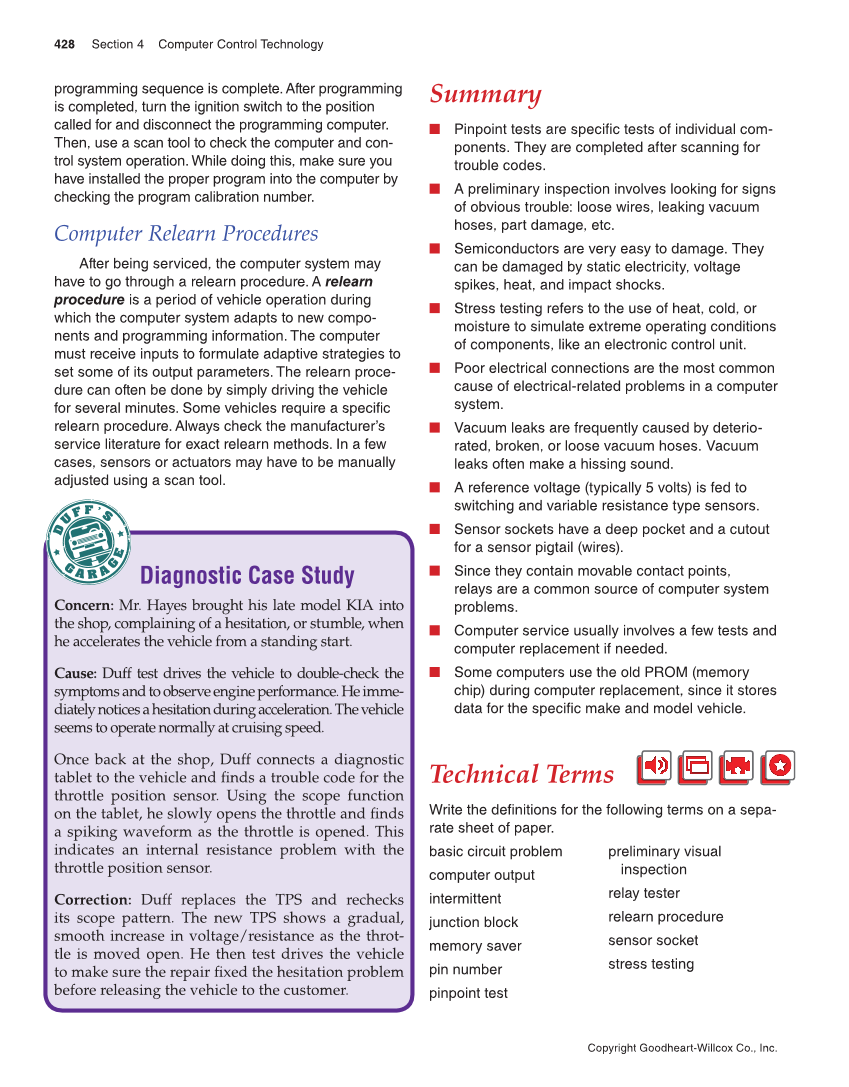428 Section 4 Computer Control Technology Copyright Goodheart-Willcox Co., Inc. G A RA G E D U F F ’ S programming sequence is complete. After programming is completed, turn the ignition switch to the position called for and disconnect the programming computer. Then, use a scan tool to check the computer and con- trol system operation. While doing this, make sure you have installed the proper program into the computer by checking the program calibration number. Computer Relearn Procedures After being serviced, the computer system may have to go through a relearn procedure. A relearn procedure is a period of vehicle operation during which the computer system adapts to new compo- nents and programming information. The computer must receive inputs to formulate adaptive strategies to set some of its output parameters. The relearn proce- dure can often be done by simply driving the vehicle for several minutes. Some vehicles require a specific relearn procedure. Always check the manufacturer’s service literature for exact relearn methods. In a few cases, sensors or actuators may have to be manually adjusted using a scan tool. Diagnostic Case Study Concern: Mr. Hayes brought his late model KIA into the shop, complaining of a hesitation, or stumble, when he accelerates the vehicle from a standing start. Cause: Duff test drives the vehicle to double-check the symptoms and to observe engine performance. He imme- diately notices a hesitation during acceleration. The vehicle seems to operate normally at cruising speed. Once back at the shop, Duff connects a diagnostic tablet to the vehicle and finds a trouble code for the throttle position sensor. Using the scope function on the tablet, he slowly opens the throttle and finds a spiking waveform as the throttle is opened. This indicates an internal resistance problem with the throttle position sensor. Correction: Duff replaces the TPS and rechecks its scope pattern. The new TPS shows a gradual, smooth increase in voltage/resistance as the throt- tle is moved open. He then test drives the vehicle to make sure the repair fixed the hesitation problem before releasing the vehicle to the customer. Summary ■ Pinpoint tests are specific tests of individual com- ponents. They are completed after scanning for trouble codes. ■ A preliminary inspection involves looking for signs of obvious trouble: loose wires, leaking vacuum hoses, part damage, etc. ■ Semiconductors are very easy to damage. They can be damaged by static electricity, voltage spikes, heat, and impact shocks. ■ Stress testing refers to the use of heat, cold, or moisture to simulate extreme operating conditions of components, like an electronic control unit. ■ Poor electrical connections are the most common cause of electrical-related problems in a computer system. ■ Vacuum leaks are frequently caused by deterio- rated, broken, or loose vacuum hoses. Vacuum leaks often make a hissing sound. ■ A reference voltage (typically 5 volts) is fed to switching and variable resistance type sensors. ■ Sensor sockets have a deep pocket and a cutout for a sensor pigtail (wires). ■ Since they contain movable contact points, relays are a common source of computer system problems. ■ Computer service usually involves a few tests and computer replacement if needed. ■ Some computers use the old PROM (memory chip) during computer replacement, since it stores data for the specific make and model vehicle. Technical Terms Write the definitions for the following terms on a sepa- rate sheet of paper. basic circuit problem computer output intermittent junction block memory saver pin number pinpoint test preliminary visual inspection relay tester relearn procedure sensor socket stress testing
